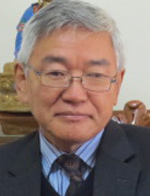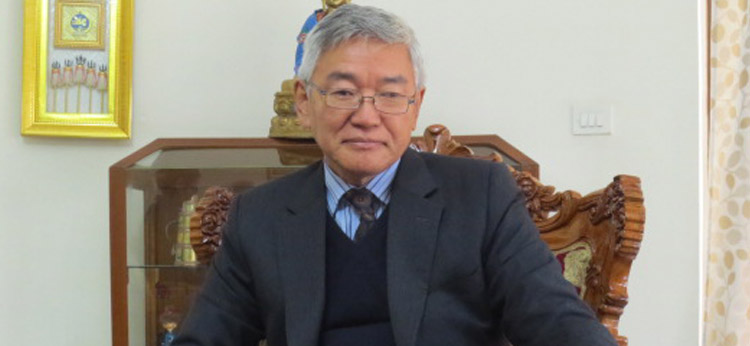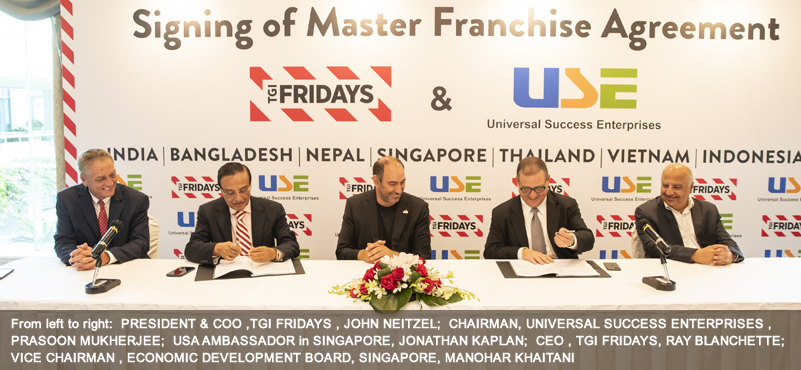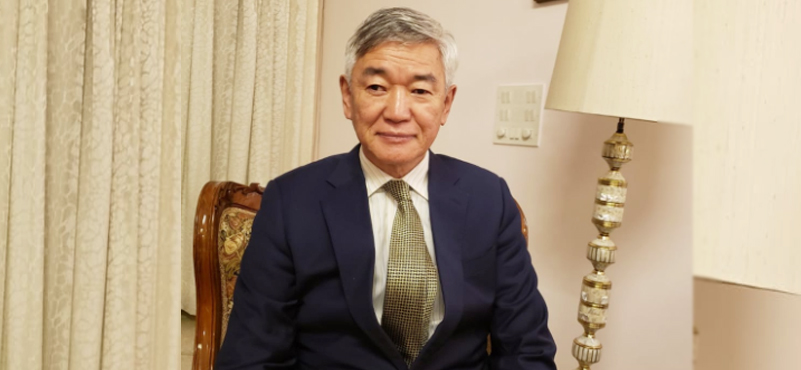Ambassador of Mongolia Gonchig GANBOLD, Ambassador of Mongolia presented his credentials to the President of India on 2 September, 2015. A polyglot, he has studied in several universities and has been a career diplomat for over three decades.

GONCHIG GANBOLD
MANGOLIAN AMBASSADOR
Mongolia and India are two of the earliest nations in Asia, if not in the world. Mongolians have got acquainted with India ever since the teachings of Lord Buddha prevailed throughout the steppe of Mongolia. I assume it had occurred even more than once. The XIII century manuscript titled as The Sacred History of Mongols (chapter 261 to 264) referred to India as Hindu or Hindustan and the Indus River as Sindhi or a New river. They have built up deep-rooted ties with shared cultural, religious and intellectual legacies that the amazing stories of great Mughal dynasty held a pivotally important role in India’s history, and there are still areas and places with thought provoking names such as Mangolpuri, Mongolbad, Mangolore in Delhi and in other parts of India.
It is my view that large number of manuscripts and literatures on our historical ties are being preserved and restored in archives, museums, libraries and research institutions in India.
Mongolians and Indians are spiritual neighbours sitting on the northern and southern edge of the Buddhist Asia. Despite geographical distance and logistic hindrances, we have been intertwined in an age old spiritual bond that turned into solid basis of state to state relations.
These traditional ties between our two peoples have grown into formal diplomatic relations when our two nations fought and regained their respective independence and sovereignty. Mongolia and India established diplomatic relations on December 24th, 1955. So as we are marking their 60th jubilee as year-long event on both sides.
We Mongolians respect India as sacred land of Lord Buddha and a source of wisdom and knowledge. Travellers of ancient past used to note that Mongolian monks were studying in Nalanda University. This spiritual tie is another basis of our close cooperation. I am pleased to note that the Government of India has been receiving Mongolian youths into its universities. Today many of them are successfully illustrating high standards of India’s tertiary education system.
Mongolia and India have contributed a wide array of arts, literature, poetry as well as research works to the oriental culture which are worth not only to be studied but also inherited to our young generation.
Shri Narendra Modi, Honorable Prime Minister of India, during his official visit to Mongolia in May this year, presented samples of Banyan tree to the main Buddhist (Gandantegcheling) monastery, which was deeply appreciated as a vivid illustration of our common spiritual legacy and close feelings toward one another.
The truth the Siddhartha Gautama, found cannot be adequately described here in this short write up. Perhaps it requires a lifetime to comprehend it. The Buddha described it in a parable. Man should seek the middle path between self-indulgence and self-mortification. This middle way, known as the Noble Eightfold path, consisted of right view, right thought, right speech, right action, right mode of living, right endeavour, right mindfulness and right consciousness. The teachings of Lord Buddha helped not only to form our people’s thoughts but also turned into philosophy with great impact on our state policy.
Sons and daughters of India hailed from diverse ethnicities and religions like Mahatma Gandhi, Pandit Jawaharlal Nehru, Netaji Subhash Chandra Bose, Baba Sahib Ambedkar, Sardar Patel, Maulana Azad, Sarojani Naidu had led the struggle of ahimsa (non-violence) against British Raj that existed over two centuries.
Likewise, Mongolians got rid authoritarian regime of one political party, 25 years ago, and embarked on a path of twin transformations such as parliamentary democracy and market economy without a single broken window-pane.
We in Mongolia know of what Swami Vivekananda had taught such as “what are what our thoughts are, so take care about what you think. Words are secondary and thoughts live, travelling far.”
The Great Genghis khan, founder of the unified Mongolian state said that winning of heart and mind is the way to govern bodies. Thus, even in the 13th century the Mongols were appreciating and respecting the diverse cultures and civilizations. So instead of discriminating or conflicting with them they used to co-exist and debate with all major faiths in their respective temples, monasteries, mosques and ashrams as Marco Polo had noted.
This year we, in Mongolia, are marking the 25th anniversary of the first free and fair elections which ushered political democracy and market economy in my country. Following the great Indian tradition of ahimsa (Non-violence) to get rid of British Raj nearly seventy years ago we launched democratic changes in Mongolia in early 1990s.
India supported these sweeping transformations from their very beginning and the Parliament of India along with fellow Asian legislative bodies made its valuable contributions in inserting democratic norms and principles into our Constitution in 1992.
India supported the transformation for political democracy and market economy in 1990’s from their very beginning and made valuable contributions in drafting our first democratic constitution. Recently, India’s high level parliamentary delegation led by Honorable Sumitra Mahajan visited Mongolia and concluded MoU to consolidate working relations between our two legislative bodies.
The Governments of Mongolia and India have defined the core principles of their relations and cooperation which was enshrined in their Joint Declaration of 1973 and reaffirmed time and again.
Since then we have concluded the treaty on friendship and cooperation in 1994, treaty on comprehensive partnership in 2008, and treaty on strategic partnership in 2015.
At present over 50 Treaties and agreements are being implemented between our countries. Thus, ties with centuries old history have grown into strategic partnership at this time of turbulent but promising perspectives.
Barring the mining sector, tourism and agriculture have substantive role in our economies. Therefore, both Mongolia and India pay much importance to climate change and environmental protection which are indeed promising areas for broader integration.
The Government of India rendered assistance to Mongolia in training our national personnel, promoting SME under its ITEC program for our professionals on short and long term trainings since 1987 and our youth are studying in the India’s universities on government and private sector’s stipends. It recently offered one billion USD Line of Credit to Mongolia that would certainly help in broadening our bilateral relations in areas like trade and economy and tourism.
Soon after my happy reunion with India, after one and half decade, having received my letter of credence as the Ambassador of Mongolia on 2 September last year, Pranab Mukherjee, President of India underlined the ancient cultural and spiritual ties between India and Mongolia.
On the following day, I had a symbolic but very important moment in my carrier as I had an opportunity to attend the international symposium on global Hindu-Buddhist initiative on conflict avoidance and environmental consciousness co-hosted by the Vivekananda international foundation of India and the Tokyo foundation of Japan. In this three day international symposium held in New Delhi and Bodhgaya, Bihar, more than anything, helped me to recall what the President of India emphasized in his brief remark on the age old ties between our two nations. Today on the occasion of the 60th anniversary of the diplomatic relations between Mongolia and India, I am pleased to underline our age old spiritual bonds have been grown as strategic partnership.
We are peace loving nations, free from any military alliances that are constructively collaborating within multilateral forums like the Non Aligned Movement, United Nations, World Trade Organization, Shanghai Cooperation Organization and UN Framework Convention on Climate Change in order to avoid conflicts and facilitate understanding and cooperation for universal well-being.
We are unanimously denounce all forms of violent extremism and expressed our firm determination to strive against religious fundamentalism and violent terrorism.




































